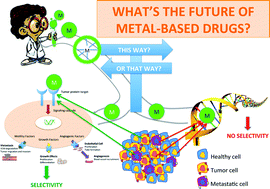Targeted therapy vs. DNA-adduct formation-guided design: thoughts about the future of metal-based anticancer drugs
Abstract
The development of metal-based anticancer

* Corresponding authors
a Department of Life Sciences, University of Trieste, via L. Giorgieri 7, 34127 Trieste, Italy
b
Callerio Foundation Onlus, via A. Fleming 22, 34127 Trieste, Italy
E-mail:
g.sava@callerio.org
c Chimie ParisTech, Laboratoire Charles Friedel (LCF), 75005 Paris, France
d CNRS, UMR 7223, 75005 Paris, France
The development of metal-based anticancer

 Please wait while we load your content...
Something went wrong. Try again?
Please wait while we load your content...
Something went wrong. Try again?
G. Sava, G. Jaouen, E. A. Hillard and A. Bergamo, Dalton Trans., 2012, 41, 8226 DOI: 10.1039/C2DT30075C
To request permission to reproduce material from this article, please go to the Copyright Clearance Center request page.
If you are an author contributing to an RSC publication, you do not need to request permission provided correct acknowledgement is given.
If you are the author of this article, you do not need to request permission to reproduce figures and diagrams provided correct acknowledgement is given. If you want to reproduce the whole article in a third-party publication (excluding your thesis/dissertation for which permission is not required) please go to the Copyright Clearance Center request page.
Read more about how to correctly acknowledge RSC content.
 Fetching data from CrossRef.
Fetching data from CrossRef.
This may take some time to load.
Loading related content
